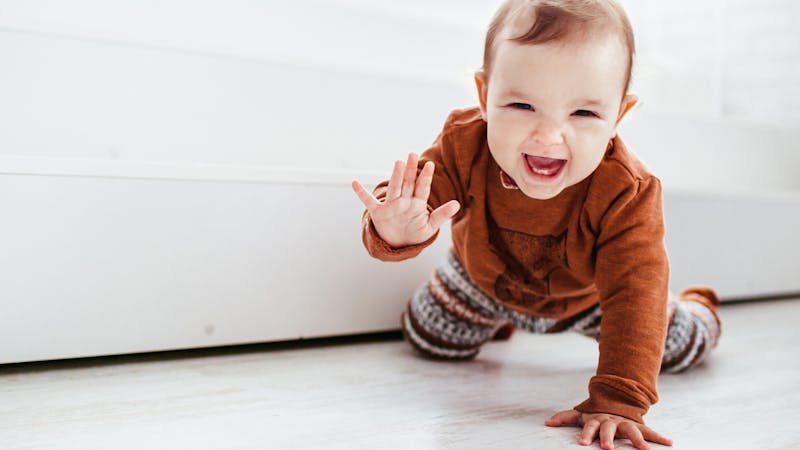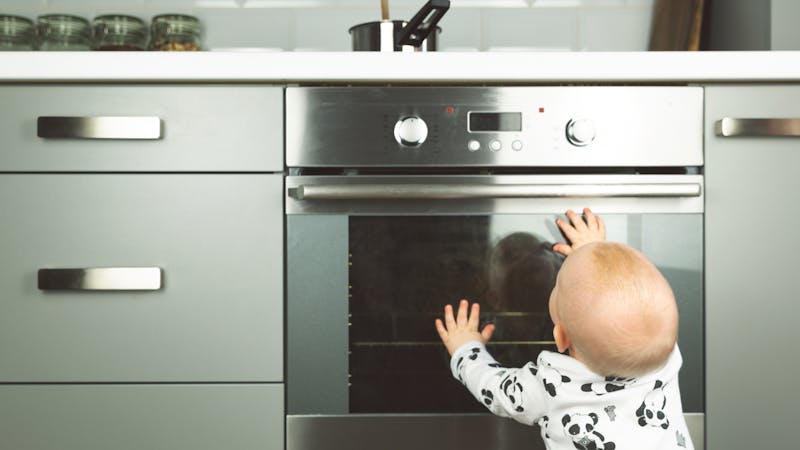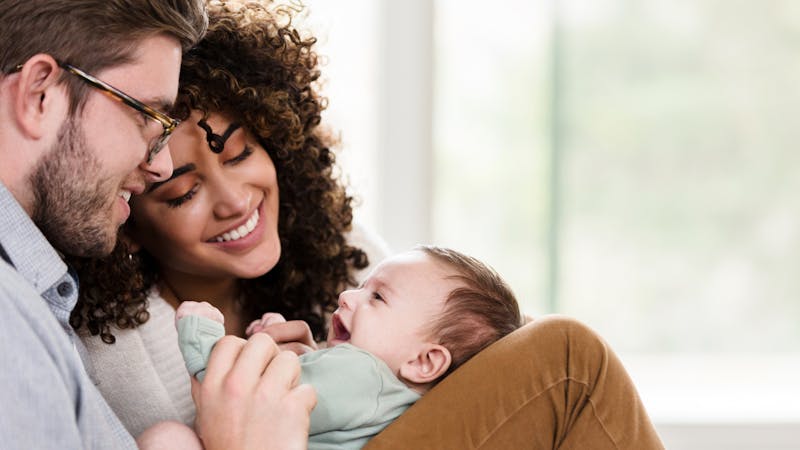Babyproofing Your Home for New Parents

When it's time to bring your bundle of joy home, you want to ensure that your home is safe and free of hazards; that's where babyproofing comes in! Ideally, new parents should start babyproofing at least three months before your due date. Some of the recommended baby-safe tips may take a little time and preparation to implement, especially in the average modern home with many hazards, like exciting WIFI units and other electronic devices.
Tons of things can be hazards to newborns, especially when they start putting things in their mouths and exploring their environment. So use this babyproofing checklist and list of baby-safe products to prepare for your exciting new chapter!
Babyproofing Checklist 101
It may surprise you just how simple it is for a baby to encounter household hazards. To ensure the safety of your little ones, it's crucial to babyproof the key areas of your home, including kitchen cabinets, outlet covers, and wires.
Babyproofing Your Home
Babyproofing your home in advance is a great way to prepare for your little ones and helps ensure their safety as they grow. Also, it's a great activity when you've got a nesting instinct.
Install detectors. If you don't have a UL-listed carbon monoxide detector in every story of your house, and you use gas or oil appliances, now is the time to install them.
Check devices. Always check the batteries of any detectors you already have, like the smoke detectors in your home, and install smoke detectors on every level of your home and in the hallways outside of every bedroom.
Tackle the big projects. If there are some big renovation projects you've been putting off completing, now is the time to get them ticked off the list. If your house was built before the 1970s, it's also very important to check if you have lead paint on the interior windows, door frames, or paint surfaces, as peeling or chipping paint can lead to lead exposure, especially for exploring little ones. (It's always recommended to enlist help from a professional to renovate and repair lead-based surfaces.)
Babyproofing Your Furniture
Furniture and wires are exciting for babies, especially as they grow and shuffle around. Still, furniture can be a hazard if not secured properly, and wires and cords can be a strangulation hazard.
Identify hazards. Spend some time sitting on the floor in each room in your home and note all the potential hazards you can see. Especially corners on coffee tables, which are potential bumping hazards, and anything with sharp edges. You can install corner guards for extra cushioning. Another top tip is to get an empty loo roll holder and put something inside; if it fits, it could be a choking hazard for young children.
Hide wires. Hide electric wires or cords for all your IoT devices with a chord sleeve, particularly around WIFI boxes, TV units, and chargers. Check out Mom Loves Best top tips for babyproofing electrical outlets.
Get rid of cords. If you have blinds or shades on your windows, make sure they are cordless since cords have been identified as strangulation hazards, or install a small hook so you can store them away.
Secure furniture. Check that all the furniture in your home and large household items (bookshelves, TVs, and cabinets) are stable and can't be pulled over by curious babies or toddlers. You can mount and secure heavier furniture to the wall using wall mounts.
Babyproofing Your Kitchen
Kitchens are full of hazards for young children, but they don't have to be with sensible babyproofing hacks. If you have low-level cabinets or an open-concept kitchen, a typical childproof gate won't cut it, but there are some things you can do.
Install locks. If you have kitchen cabinets young ones can reach, now might be the time to install childproof safety locks because before you know it, they will be moving around and exploring. You might even consider putting a baby lock on your fridge and oven door to babyproof them.
Check door latches. Young kids love to explore, and it's necessary for their development, so ensure that you’ve got safety door latches so little fingers can’t get stuck or hurt. This way, you will be happy for them to explore, knowing their safety.
Install smart storage. Your home has to work for you, so installing smart storage that isn’t reachable by little hands is key. Get into the habit of turning pot handles inwards. That way, when your baby is mobile, they aren’t going to be able to reach for the enticing pot of hot food.
12 Babyproofing Products to Prepare Your Home
Here is our round-up of the best babyproofing products, and babyproofing hacks to make your nesting and baby-safe checklist easier.
-
Baby Monitor
A smart WIFI-enabled baby monitor is a new-parent essential device. These gadgets are invaluable tools for your peace of mind; some modern monitors can even track biometrics. How about that for the IoT? Nanit Pro Smart award-winning monitors are well-loved by many new parents.
-
Smart Baby Gadget Heating
For another WIFI smart gadget, consider babyproofing by stabilizing your home's temperature with a smart thermostat device. Experts recommend a baby's room should be between 62 to 68 degrees Fahrenheit. If you’re after a humidifier, this one by Levoit works with Alexa and the app.
-
Corner Guards
Need to keep your little one from bumping into sharp corners? Baby Earth is your one-stop shop for soft corner guards for babyproof furniture.
-
Sleepwear
For new parents, sleep time can be a nerve-wracking experience, especially at the beginning, as you get used to your baby's sleeping patterns and rhythms. Consider investing in smart sleepwear that monitors baby's breath and sleeping patterns comfortably; you will need a good WIFI connection to use the app.
-
Wall Mounts
With so many options, anchoring heavy furniture to the wall can be confusing. National Hardware's Anti-tip kit is a great all-rounder for child safety, and if you need advice on how to anchor furniture to the wall, head to Charleston Crafted.
-
Babyproof Carpets
If you've got slippery or hard floors in your house, it might be worth getting some colorful rugs with anti-slip, non-skid rug liners or soft carpeting to cushion bumps and falls. You can easily find these in local stores or online.
-
Outlet Covers
You will want to cover exposed electrical outlets with something durable and babyproof to stop little fingers from exploring inside; as their name implies, they plug into or cover outlets. You can choose from three main types; Bink safety plugs are an easy, budget-friendly option.
-
Smart Speakers
This one isn't strictly for babyproofing, but it could help soothe your baby to sleep. The Soundbub smart speaker is Bluetooth-enabled, portable, and made of chew-safe materials. You can use the built-in white noise, which creates a womb-like environment, or record your voice on the app.
-
Cabinet, Door, and Window Locks
Windows, doors, and cabinets can be hazardous for young children, so to prevent little fingers from getting trapped, consider putting baby-safe locks and guards on them. Child-proof locks come in many shapes and sizes, depending on your needs. Eco-baby magnetic locks go inside the cabinet, and they're invisible. For door stops and door finger protection, Dreambaby has got you covered.
-
Toilet Locks
Toilets are an explorer's dream, so if you want to avoid finding your iPhone taking a plunge, invest in a toilet lock. There are fewer good options out there than you might think, but Munchkin latches are a babyproofer's dream, as are Mummy's Helper Lid-Lok Safety Latches.
-
Safe Cribs
Choosing a safe babyproof crib for your little one to snuggle into is vital. Of all the babyproofing products, this is by far the most important. Babyletto specializes in Greenguard Gold Certified modern, sustainable, long-lasting nursery furniture. For a more budget-friendly crib option, check out Delta Children.
-
Safety Gates
Safety gates are important to have around your home to stop tumbles down the stairs, older babies crawling into rooms they shouldn't, and other danger zones. For quick and easy installation, try Regalo's Easy Step, or for a more stylish option, Munchkin's baby gate products make it effortless.
Resources:
- Parents - 10 Surprising Safety Hazards
https://www.parents.com/baby/safety/babyproofing/safety-hazards/ - Ball, H.L., Keegan, AA. Digital health tools to support parents with parent-infant sleep and mental well-being. NJP Digit. Med. 5, 185 (2022).
https://doi.org/10.1038/s41746-022-00732-4 - Dao A, McMullin J. Unintentional Injury, Supervision, and Discourses on Childproofing Devices. Med Anthropol. (2019)
https://www.ncbi.nlm.nih.gov/pmc/articles/PMC6342623/ - The Kavanaugh Report. Baby Proofing in a Montessori Home.
https://www.thekavanaughreport.com/2018/01/baby-proofing-in-montessori-home.html


